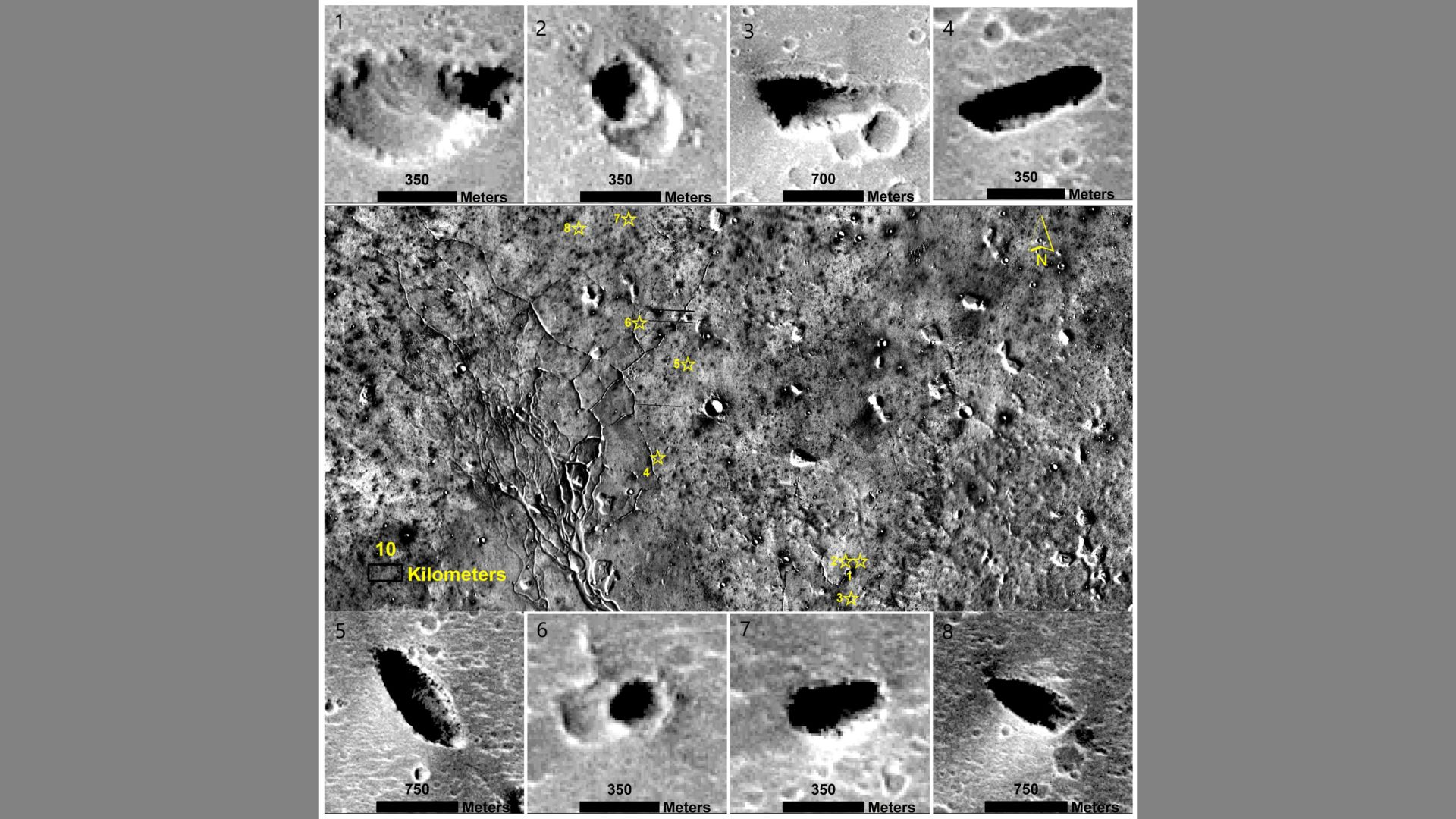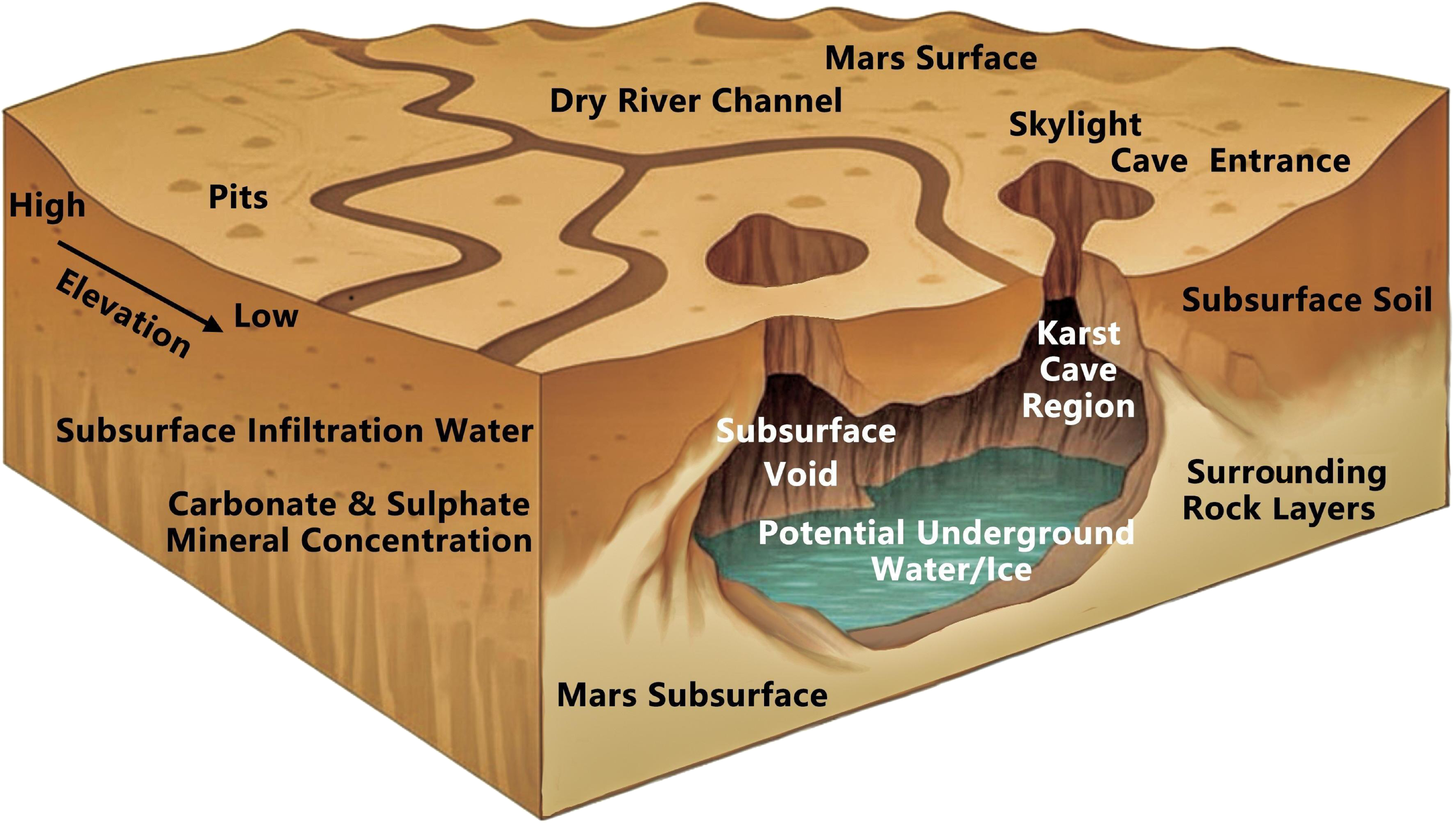Evidence of ancient life on Mars could be hidden away in colossal water-carved caves
Skylights, openings in the surface of Mars that descend down into caves, have been found on Mars, along with signatures for the presence of water ice.

Possible giant "karstic" caves that formed when slightly acidic water dissolved bedrock have been identified on Mars and hailed as one of the best locations on the Red Planet to search for preserved biosignatures.
"With the expected technological advances in the coming decades, if missions are specifically designed for these targets, we believe that in situ exploration of Martian karstic caves is an achievable goal," said Chunyu Ding, of the Institute for Advanced Study at Shenzhen University in China, in an interview with Space.com.
The caves, in the Hebrus Valles region between the extinct volcano Elysium Mons and Utopia Planitia in Mars' northern mid-latitudes, are revealed by eight skylights, which are holes in the ceiling of the caves that are visible on the surface as pits ranging from tens to over 100 meters across. The skylights are distinguishable from craters because they don't possess raised walls or splashes of ejecta around them. It is thought that the skylights form when the surface partially collapses into the empty cave below it.
Caves and skylights have been found on Mars before, but as lava tubes formed in volcanic regions. Hebrus Valles, on the other hand, is not a volcanic region; it displays ancient river channels and copious hydrated minerals and sediments deposited by bodies of liquid water on the surface long ago.
These features were identified by scientists led by Ding and his Shenzen colleague Ravi Sharma. Their team used archive data from a variety of Mars missions, including mineralogical maps based on observations by the Thermal Emission Spectrometer on NASA's now-defunct Mars Global Surveyor, hydrogen detections (as a proxy for water) from the Gamma-Ray Spectrometer on the agency's Mars Odyssey, and models of the Martian terrain built around data from the HiRISE camera on NASA's Mars Reconnaissance Orbiter.
They determined that the skylights and their surroundings are consistent with what's termed "karstic" caves. Karstic refers to the dissolution of carbonate- and sulfate-bearing bedrock. While we find karstic caves in many locations on Earth, this is the first time that they have been identified on Mars.
The observations show that the Hebrus Valles region is rich in carbonate rock such as limestone and sulfate rock such as gypsum. Over 3.5 billion years ago, when Mars was warmer and wetter, these carbonate and sulfate sediments were laid down by large pools of liquid water, such as lakes and seas. When Mars grew cold, the surface water went away, much of it forming sub-surface ice and frozen brines.
Breaking space news, the latest updates on rocket launches, skywatching events and more!
Indeed, the Gamma-Ray Spectrometer data from Mars Odyssey points to water ice possibly still existing there in some quantity. At some point, local heating events, perhaps from distant volcanoes, impacts or long-term orbital variations, would have melted the subsurface ice and brines, and the liquid water would have run through cracks and fractures in the ground, dissolving the rock and turning those cracks into large caves.
Not all regions of Mars meet the requirements to form karstic caves, since for one thing carbonate and sulfate rocks are not omnipresent. Nor do all locations, particularly lower-latitude areas, host subsurface ice and frozen brines or have been geologically stable for long enough to allow the caves to form and their rocky ceiling to collapse and form the skylights.
"Our results suggest that Hebrus Valles is unlikely to be a completely isolated case, but these caves also will not be everywhere on Mars," said Ding. "They are likely concentrated in a limited set of regions that satisfy the necessary depositional and hydrological conditions. It is quite reasonable to expect more karstic caves to be discovered in other, similar environments in the future."
Indeed, more than just the eight caves may be present in Hebrus Valles; there could be others that have not yet experienced a ceiling collapse and revealed themselves. Of those known so far, the skylights appear to be several tens to over 100 meters across, and underground the cavities could be several times larger still, and tens of meters deep.
Karstic caves are the perfect location to preserve ancient biosignatures. The watery and stable microclimate within the caves long ago could have hosted microbial colonies, and today the caves are protected from the extreme conditions on Mars' surface, such as wildly different diurnal temperatures, dust storms and solar ultraviolet and cosmic-ray radiation. Hence future life-seeking missions may seek to explore them.
However, the surrounding rock will limit the transmission of radio signals from inside the caves to orbiting spacecraft, making exploration of the caves more difficult, but not impossible, said Ding.
"From an engineering standpoint, directly entering these caves is a major challenge," he said. "However, our geomorphological analysis suggests that not all candidate caves are simple vertical shafts. In our paper, we use the term 'accessible potential karstic caves.'"
Most of the skylights are characterized by steep walls descending down into the darkness of the caves, but among the eight Hebrus Valles caves there is evidence for slopes made by rocky debris in multiple, step-like formations that might allow a staged descent.
This could be accomplished by multiple robotic explorers forming a communications chain down into the caves, ranging from wheeled rovers that carefully navigate down each step, to climbing robots lowered by winches or aerial rotorcraft that can fly in and out of the skylights.
The cave's rocky shielding might not only lend itself to preserving biosignatures, but could also offer protection to future Mars astronauts, shielding them and their outposts from the hazards of radiation and dust storms on the surface. If so, it could be that humanity's future on Mars is to be found underground.
The conclusions of Ding's team were published on Oct. 30 in The Astrophysical Journal Letters.

Keith Cooper is a freelance science journalist and editor in the United Kingdom, and has a degree in physics and astrophysics from the University of Manchester. He's the author of "The Contact Paradox: Challenging Our Assumptions in the Search for Extraterrestrial Intelligence" (Bloomsbury Sigma, 2020) and has written articles on astronomy, space, physics and astrobiology for a multitude of magazines and websites.
You must confirm your public display name before commenting
Please logout and then login again, you will then be prompted to enter your display name.

